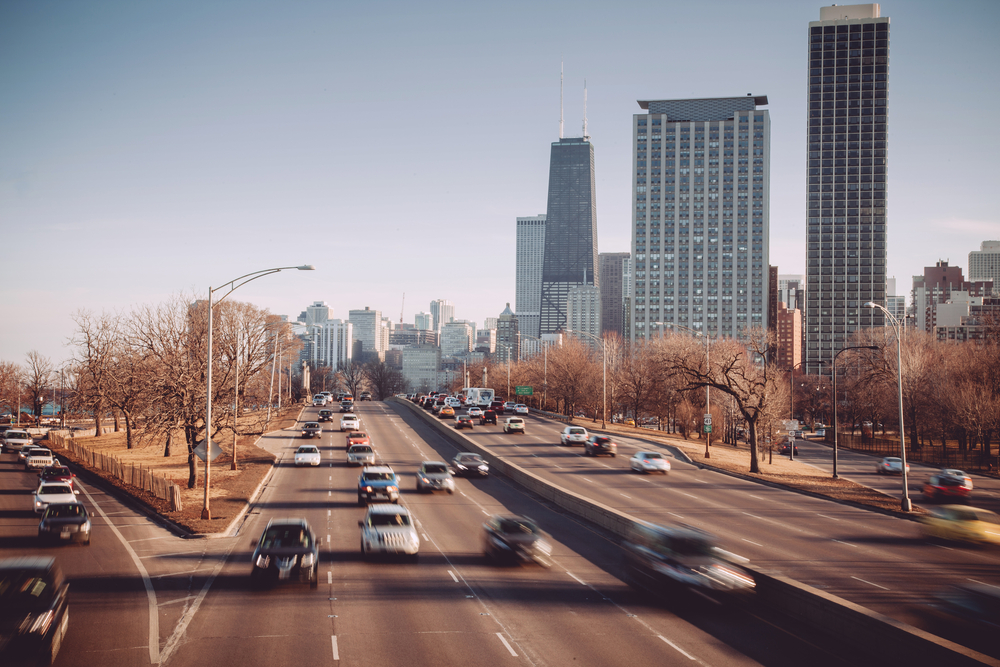

March 18, 2024
Is Chicago walkable? A guide to getting around the city
Chicago is America’s Midwest metropolis. In fact, it’s the third-most populous city in the United States, behind New York City and Los Angeles. A metropolitan area of this size makes out-of-towners wonder if Chicago is walkable, or if they’re better off getting around by car or public transportation.
The truth is, like any major city, downtown Chicago is walkable and its grid street system makes it easy to navigate. However, the city and its sprawl are large, and some routes may be too far for you to want to cover on foot, like the Magnificent Mile to Wicker Park (3.7 miles) or Grant Park to Wrigley Field (5.1 miles). So what is the next-best option? We’ll break down the various — and best — ways to get around Chicago so you can navigate with ease on your next visit.

Top 5 ways to get around Chicago
Luckily, a big city like Chicago has multiple ways to get around. Because of that, you won’t have to rely on just one method of transportation, which is good news if the destination is far or if there’s a traffic jam. Learn what options are available so you can mix and match according to cost, distance, travel time and comfort.
1. Walking
Is Chicago walkable? Yes it is, especially when you’re downtown in River North or the Loop, which is the city’s central business district with parks, museums, shops, restaurants, attractions and more of the best things to do in Chicago. The city’s sidewalks are wide and roomy, there are plenty of crosswalks and exploring on foot allows you to discover little gems you might otherwise miss when speeding by on the street or in the L train. So go ahead and bring your comfy shoes to Chicago. If the distance isn’t too far and you’re not in a hurry, then walking is a great way to explore the city.
2. ‘L’ trains
The Chicago Transit Authority (CTA) operates a metro train system, which is called the ‘L’ because it partially runs on elevated tracks instead of underground, like in many other cities. There are eight different color-coded lines that snake throughout downtown and well into the neighborhoods. The ‘L’s reach makes it an affordable option for longer trips since a regular one-way train fare is $2.50 (or $5 for a day pass). Before you head to the ‘L’, check the rail status and system alerts to make sure there aren’t any major delays that will slow down your trip, and download the Transit Stop app on Apple or Transit Tracks app on Google Play to check the schedule.
3. Bus
The CTA’s bus service is another great public transportation option in Chicago, with extensive coverage throughout the city on 128 routes. But don’t let this large route network intimidate you! CTA’s website provides plenty of information about how to ride the bus in Chicago, including guides with step-by-step instructions and tips to make your experience a smooth one. You can also track buses’ real-time status so you know how long you have to wait until the next one arrives at your stop.
4. Car
You can get around quickly by car, and driving in downtown Chicago is pretty easy thanks to the city’s grid street system. The biggest things to be aware of when you’re behind the wheel are pedestrians, cyclists and one-way streets. If you’re taking a car into the city for the day, you have a variety of options for parking in Chicago, including free parking, discounted parking (through a validated pass at a participating business), street spots and garages.
5. Taxis and rideshare
If you’d rather not drive, then a taxi or rideshare are good options in Chicago. Arro and Curb are the two official apps for Chicago taxicabs, allowing you to order a car and pay your fare through the app. Or you can choose rideshare services like Uber and Lyft. These options can get expensive, so consider how often you’ll need a car and weigh the cost against renting for the day.

Exploring outside the city
There is certainly plenty to do in Chicago, but for the times you want to explore beyond the city limits or take a family road trip, renting a car is definitely the best option. For a fast and easy pick-up and drop-off experience, choose Avail car sharing. We have 30+ self-service locations in neighborhoods around Chicago where you can get on your way quickly, without waiting in a single line. Plus, every trip is protected by Allstate insurance and 24/7 roadside assistance so you can enjoy your time away with peace of mind.
FAQ about getting around Chicago
Is Chicago a walkable city?
Yes, downtown Chicago is walkable. Sidewalks are wide, there are plenty of crosswalks and the city’s grid street system makes it easy to navigate. Major attractions, like Navy Pier, Willis Tower, the Magnificent Mile and the Art Institute of Chicago, are within walking distance of each other. If you want to explore different areas you may need to drive or take public transportation to get there, but most neighborhoods are very walkable as well.
What is driving in downtown Chicago like?
Driving in downtown Chicago is similar to driving in other major U.S. cities. You can expect one-way streets, many pedestrians and cyclists, buses sharing the road and heavy traffic during rush hours. Be patient, but at the same time, drive defensively to keep with the flow of traffic.
What are the benefits of a car versus public transport?
Chicago’s public transportation system covers a lot of ground and is a good option for traveling inexpensively around the city. With a car, however, you can take the most direct route between your origin and destination, and have the freedom to stop along the way. If you’re traveling with luggage, shopping purchases or items for a day trip, like beach accessories and a cooler, a car makes the trip easier and more convenient. The question of whether you need a car in Chicago depends on your itinerary, how much time you have, what items you’re taking along, how many people are traveling with you and whether you want the flexibility to change your plans during your trip.
How do you ride the bus in Chicago?
You can buy a one-way ticket with cash directly from the bus driver (no change is given) or add fare value to a reloadable Ventra Card that you’ll tap on the reader after you board the bus. Go to the nearest bus stop for the route you need to take and wait for the bus to arrive. As it approaches, look for the route number and destination signs at the top of the bus to make sure it’s the one you need, since one stop can serve multiple routes. As the correct bus approaches, wave your hand to let the driver know that you’d like them to stop for you. If there are no open seats and you need to stand, walk as far toward the back as possible to make way for other passengers. When your stop is next, pull the stop request cord or push a stop request button to indicate to the driver that you’d like to get off.
What is the best area to stay in Chicago without a car?
If you are going to Chicago to visit the top attractions downtown, then you are best off staying in River North, which is just north of the Loop, the city’s central business district. However, since you can easily access this area via local buses and ‘L’ train lines, you can choose to stay near any ‘L’ or bus stop and use public transportation to get to and from downtown.
Hit the road with Avail
Discover how easy it is to borrow a car whenever you need to drive.





